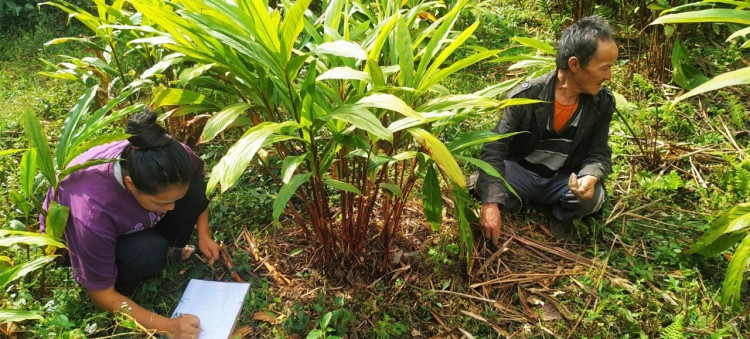




















Monday, Jan 20, 2025 11:15 [IST]
Last Update: Monday, Jan 20, 2025 05:39 [IST]
New mission comes with fundamental changes, endgame is to increase crop’s lifespan
GANGTOK,: The Sikkim government has conceived the ‘Mero Alaichi, Mero Dhan’ initiative to revive large cardamom cultivation in the State through cutting-edge scientific and technological interventions.
Under this initiative, the Department of Biotechnology (DBT), Government of India has extended support by convening an expert group of nation’s leading experts to develop a comprehensive ‘strategy and action plan’ to revive large cardamom in Sikkim.
“The ‘strategy and action plan’ for the crop's revival is expected to be developed in a month. Following this, field experiments will be initiated to tackle the disease by leveraging cutting-edge biotechnology, genetic diversity, and eco-friendly biocontrol methods,” said the State Science & Technology department.
In past, Sikkim used to be a major producer of large cardamom with hundreds of farming families, especially in western and northern regions, dependent on this cash crop. Over the years, large cardamom has been ravaged by climate-change-induced diseases that have taken the form of an epidemic, reducing cultivation by 50 per cent. Earlier, about 25000 hectares of land were under large cardamom cultivation but at present, it has declined to about 12500 hectares. Annual production has dropped to 2500 metric tons from the earlier output of 5152 metric tons.
This crisis has reduced the productive lifespan of the crop from 30 years to a mere 5-6 years, severely impacting both farmers and the agricultural economy of the region.
Recognizing the imperative need to revive this iconic crop of Sikkim, Chief Minister PS Golay last year directed the Science & Technology department to take stronger measures to boost the cultivation and production of large cardamom in Sikkim. He chaired a high-level meeting on October 24, 2024, to discuss with the department on the initiative to revive large cardamom.
The Chief Minister, at the meeting, emphasized that these efforts, under the close supervision of the relevant departments, would directly benefit farmers at the grassroots level, enhancing the economic security of rural communities.
Consequently, the ‘Mero Alaichi, Mero Dhan’ (My Cardamom, My Wealth) was launched which proposes innovative biocontrol, biotechnological, and plant breeding approaches to tackle the disease plaguing large cardamom cultivation in Sikkim. The initiative has been given a high priority by the Government of India, it was informed.
The Science & Technology department informed that the DBT-constituted expert group includes premier biotechnology institutes such as the Institute of Bioresources and Sustainable Development (IBSD), the International Centre for Genetic Engineering and Biotechnology (ICGEB), the National Institute of Plant Genome Research (NIPGR), the National Centre for Biological Sciences (NCBS), and the National Agri-Food Biotechnology Institute (NABI) and others.
Eminent plant pathologists, plant geneticists, biotechnology experts, and private firms have also been roped in to share their expertise and insights. The Science & Technology department, jointly with the Horticulture department, is coordinating this collaborative effort. The initiative aims to address the root causes of the large cardamom epidemic, devise innovative solutions, and test them in farmers' fields. Three meetings have been held over the last few months to take this initiative forward in mission mode.
“The ‘Mero Alaichi, Mero Dhan’ initiative is a testament to the Government of Sikkim's commitment to preserving the State’s agricultural heritage. This initiative has the potential to help the State's large cardamom sector reclaim its role as a source of wealth, identity, and resilience for rural communities. It can also significantly contribute to the overall vision of the State government of a ‘Sunaulo, Samriddh, and Samarth Sikkim’,” said the Science & Technology department.
Large Cardamom Revival: The Way Forward
The Problem: Large cardamom, once the major revenue generator for Sikkim farmers, suffered various viral and fungal diseases over the years. Cultivation area dropped drastically from 25,000 hectares to 12,500 hectares while annual production declined to 2500 metric tons from 5152 metric tons.
What was happening: Large cardamom fields across Sikkim were infected with a fungal epidemic, cutting down the cash crop’s lifespan to 5-6 years from 30 years. A farmer spends 3-4 years to grow the sapling but is getting only 2-3 years of harvest before the plant dies. His efforts are not matched with the longevity and production, and thus unsustainable.
So far the revival efforts have been mostly to replace the infected plants and plant new saplings. The new plant survives for 5-6 years before getting re-infected as the fungal diseases already exist in the ecosystem.
What is the New Mission: The Sikkim government’s ‘Mero Alaichi, Mero Dhan’ is fundamentally different from other ongoing efforts to revive large cardamom cultivation. The new initiative’s endgame is to increase the large cardamom’s lifespan to around 8-10 years where it becomes economically beneficial for the farmer.
Biotechnology would be harnessed to achieve this objective for which the Government of Sikkim has partnered with the nation’s leading biotechnology institutes and Department of Biotechnology, Government of India.
Suitable bio-controlled measures would be identified and used to control the viral and fungus diseases which are affecting large cardamom plants. The initiative also aims to develop cross-breed varieties of large cardamom of seed origin that are resistant to diseases and other climate-induced challenges.
At the Moment: The Department of Biotechnology (DBT), Government of India has formed an expert group to develop a comprehensive ‘strategy and action plan’ to revive large cardamom in Sikkim. This group includes premier biotechnology institutes, eminent plant pathologists, plant geneticists, biotechnology experts, and private firms.
The ‘strategy and action plan’ for the crop's revival is expected to be developed in a month.
The departments of Science & Technology and Horticulture have already held three meetings with the DBT and various national biotechnology institutes to take this initiative forward in a mission mode.
Following this, field experiments will be initiated to tackle the disease and depending on the outcome, recalibrate the plans and extend the same across Sikkim to reclaim the lost lands under large cardamom.
Pic: The Science & Technology department officials discussing the mission with Chief Minister PS Golay on October 2024.
